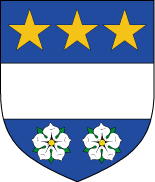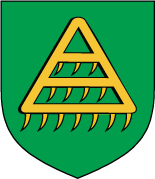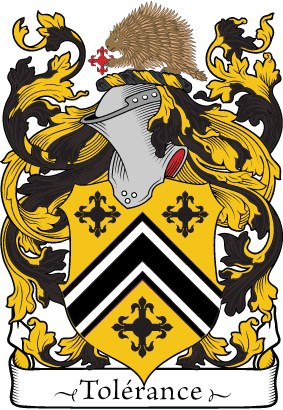The Armorial Bearings of John P. DuLong
IntroductionSince childhood I have been fascinated with heraldry. As I made progress doing my genealogy I learned that several of my Canadian ancestors were nobles and bore arms. Although I descend from the armigerous de Jordy, Robineau, Le Neuf, Le Gardeur, Le Marchant, Corday, Baillon, and de Marle families and through them from many other armigers, I knew that my paternal immigrant ancestor, Richard Dulong, was a simple commoner. The Dulongs of Lieurey, Normandie, France, never carried arms.
As I studied French heraldry I learned that in French custom—unlike English practices—anyone could assume unique arms that did not duplicate another person's arms. In fact, during the reign of Louis XIV, in 1696, many successful bourgeoisies and peasants were encouraged to adopt arms. This was done so that they could be taxed for the privilege. I considered arranging for a grant of arms from the College of Arms in England. I could have pursued this approach, because my paternal great-grandfather, François-Édouard Dulong of St-Roch-de-l'Achigan, Québec, was a British subject. Moreover, in the United Kingdom people with professional credentials, such as a doctorate, are considered gentlemen and eligible to have a grant of arms. However, I found the cost of going through the College of Arms prohibitive. Eventually, I learned that since the United States lacks an official heraldic authority with the power of legal enforcement, that I am on reasonable safe ground in assuming my own arms as long as they do not violate another person's arms. I resolved to design and assume my own arms relying on resources available to an American.
Registration of ArmsThe American College of Heraldry is an unofficial body that registers arms for Americans. They will also help you design your arms. I contacted them and worked with the president, the late Dr. David Pittman Johnson, who helped me design my arms. The resulting design was drawn by the late Dennis Endean Ivall of Cornwall, United Kingdom, in the American or English style. The College provides a black and white drawing of the arms as part of the registration process and it is shown here: The beautiful certificate of registration issued by the American College of Heraldry displays the same drawing but in color. This certificate is now framed and hangs in a prominent place in my home office. Here is the text of the certificate which includes the blazon and a colored version of the arms:
Being styled "Dulong of Oakland" on the certificate was somewhat surprising to me and uncomfortable. I understand that assigning such territorial designations is no longer the practice of the American College of Heraldry. Subsequently, as part of the American College of Heraldry's normal practices, an announcement of my arms was published in a short article entitled "The Armorial Bearings of John Patrick DuLong," The Armiger's News 11 (Summer 1989): 2, and my arms were then displayed in The Heraldic Register of America, 14 vols. to date (Tuscaloosa, AL: The American College of Heraldry, Inc., 1985-), vol. 5, p. 29. Furthermore, I took the precaution of having my blazon and achievement of arms copyrighted ("Blazon of the Armorial Bearings of John Patrick DuLong," text copyright, registration number TX 3-293-999, 6 May 1992; and "Achievement of Arms of John Patrick DuLong," visual art copyright, registration number VA 505-323, 6 May 1992). My arms have also been registered with the United States Heraldic Registry under number 20070204K. Lastly, I also submitted my arms to the Committee on Heraldry, New England Historic Genealogical Society. Design ConsiderationsPerhaps a few words are appropriate about the design of my arms. I wanted to use a charge that would emphasize my French heritage. However, the fleur-de-lis, which comes to mind first, is over used. Hence, I developed the charge that combines a cross fleury and a roundel. It has the look and feel of a French charge. I employed the chevron ordinary because it was often used in French arms registered in the seventeenth century. The metals and colors I chose were based on playing with a number alternatives and settling on what pleased me the most. I wanted the crest to reflect the Canadian heritage of my French Canadian and Acadian ancestors. Too often the beaver and the maple leaf appear in arms of Canadians. So I wanted to avoid these images—along with the moose, buffalo, bear, and loon—for the crest. I resolved to use a North American porcupine to give my crest a New World flavor. This blends nicely with the French tradition since King Louis XII used an European hedgehog and crown as his badge. Lastly, I picked the motto "Tolérance" because one of my heroes as a child was King Henry IV of France and Navarre. It was he who promulgated the Edict of Nantes that allowed limited religious tolerance for the Huguenots of France. The toleration of others, even those with whom we disagree, is an important principle for me. Heraldic HeiressesIt is necessary to point out that these arms are my own, personal arms. They are not the arms of the DuLong surname, just of John P. DuLong. (For illustration of armorial bearings used by other DuLongs please see my web page on the origins of the DuLong surname.) The only people with a right to inherit and bear my arms are my known descendants. My daughters, who have also been registered with the American College of Heraldry, Marie-Renée Adrienne DuLong, Marie-Angélique Belle DuLong, and Marie-Elise Gabrielle DuLong, are heraldic heiresses, that is, they can pass the arms on to their own children because they lack a brother. My arms could be quartered with my grandchildren's fathers' arms (assuming their fathers are armigers). Displayed here are the arms of my daughters, using the Canadian system for female cadency:
Variations in PresentationIn general, a drawing of arms must stay loyal to the blazon, but this does not mean that the armiger is locked into the original drawing made for the grant, confirmation, or registration of arms. Part of the joy of having arms is playing with the elements of the arms and varying the presentation of the arms. As an American of both French and Irish ancestry, it is intriguing to play with different styles of heraldry and apply them to my arms. Since I wanted to follow French heraldic practices as much as possible, I decided to have a simple drawing of my arms done on a French style shield. Commoners in France were not allowed to use helmets or coronets on their achievements, though many ignored this rule. I hired the late Richard McNamee Crossett of Louisville, Kentucky, to draw my arms in a seventeenth century French fashion using hatchings which is displayed below:
I rarely use the full drawing of my arms and prefer to follow French practices for commoners and just display my arms on a shield without any helmet, mantling, wreath, or crest. The above drawing is all that I use on my stationery. In 1999, curious to see what my arms would look like in the French style, I asked Mr. Crossett to redraw my full arms according to French heraldry traditions. The pleasing result follows:
Based on Mr. Crossett's artwork I have produced a drawing of my crest and also my crest in a circlet seal with my motto and the year I registered my arms. In addition I have created the "DuLong knot." Heraldic knots are an English tradition, but as an American I feel comfortable incorporating English elements (and the truth is that I have traces of English and Scottish ancestry). This knot is based on the flourish I frequently found following the signature of my ancestor Gabriel Dulong. He was a merchant in Lieurey and the father of the immigrant Richard Dulong. The knot can be used as a symbol associated with my family. Lastly, I have created the "DuLong badge," another heraldic tradition more common perhaps in the United Kingdom than in France.
Arms without a banner are incomplete, so here, in the English style, are my arms and banner. Another drawing done in the English style without the banner:
Being very proud of my maternal and dash of paternal Irish ancestry how could I neglect representing my arms in the style of Ireland with the distinctive gules and argent mantling often used in this tradition:
Though I have only a few distant Scottish ancestors, in honor of the Old Alliance between Scotland and France, here are my arms in the Scottish style:
Now something a little more in the Medieval style.
Lastly, just for fun, here are my arms in the Rococo style popular among the French in the seventeenth century:
Patricia's ArmsOn 20 September 2005 my wife, Patricia A. (McGuinness), and her family registered arms with the American College of Heraldry for the descendants of John Parnell McGuinness. Here are our marital arms impaled together:
The motto is from the Hamiltons, from whom my wife descends, and translates as "Virture Alone Enobles." We have selected this motto as our own joint motto. To learn more about my wife's arms point your browser to the Amorial Bearings of the Descendants of John Parnell McGuinness. ReferencesI realize that many people, especially those raised in the tradition of English heraldry, will object to the assumption of arms. However, I am confident of my interpretation of French heraldry practices, in both France and New France, and American heraldry traditions based on my reading of the following literature: American Heraldry Society. "Guidelines for Heraldic Practice in the United States Recommended by the American Heraldry Society," http://americanheraldry.org/pages/index.php?n=Guide.Guidelines, accessed 19 August 2007. American Herladry Society. "Heraldic Registration in the United States," http://americanheraldry.org/pages/index.php?n=Registration.Domestic, accessed 19 August 2007. Beddoe, Alan Beddoe. Canadian Heraldry. Belleville, ON: Mika Publishing Co., 1981. Crayencour, Georges de. Dictionnaire héraldiques. 2nd rev. ed. Paris: Editions Christian, 1985. Duke de la Force. "Seven Centuries of International Heraldry: France." World Conference on Records and Genealogical Seminar. Area J-2a. Salt Lake City, UT: The Genealogical Society of the Church of Jesus Christ of Latter-day Saints, 1969. Fauteux, Aegidius. "Armorial du Canada français." 2 vols. Typed manuscript at the Salle Gagnon, Bibliothèque centrale de Montréal, n.d. Haucourt, Geneviève d', and George Durivault. Le Blason. Paris: Presses universitaires de France, Que sais-je? series, no. 336, 1949. Massicotte, Édouard-Zotique, and Régis Roy. Armorial du Canada français. 2 vols. Montréal: Beauchemin, 1915-1918. Mathieu, Rémi. Le système héraldrique français. Paris: J. B. Janin, 1946. Morenas, Henri Jougla de, and Raoul de Warren. Grand Armorial de France. 7 vols. Paris: Les Editions Héraldiques, 1934-1952; reprint ed., Paris: Frankelve, 1975. [This is the largest single collection of French arms in print.] Mousnier, Roland E. The Institutions of France under the Absolute Monarchy, 1598-1789: Society and the State. 2 vols. Brian Pearce and Arthur Goldhammer, trans. Chicago: Univ. of Chicago Press, 1979-1984, pp. 112-120. Olivier, Eugene. Manuel de l'amateur de reliures armoriées françaises. 29 vols. Paris: C. Bosse, 1924-1935. [Excellent white on black drawings of French royal, imperial, and famous noble arms collected from armorial bookbindings.] Pastoureau, Michel. Traité d'Héraldique. 2nd ed. Paris: Picard éditeur, 1993. Pichette, Robert A. "Early French-Canadian Heraldry." Heraldry in Canada 2 (September 1968): 20-28. Pine, L. G. International Heraldry. Rutland, VT: Charles E. Tuttle Co., 1970, pp. 147-159. Renesse, comte Théodore de. 1894-1903. Dictionnaire des figures héraldiques. 7 vols. Bruxelles: O. Schepens, 1894-1903. Reprinted in one volume (Leuven: Jan van Helmont, 1992). [Used in conjunction with Rietstap ([1861] 1884-1887) 2nd ed.] Reynolds, J. A. Heraldry and You: Modern Heraldic Usage in America. New York: Thomas Nelson & Sons, 1961. Rietstap, Johannes Baptist. Armorial général. 2nd ed., much enlarged. 2 vols. Gouda: G. B. van Goor, [1861] 1884-1887. Rolland, Victor, and Henri Rolland. Armorial général de J. B. Rietstap, Supplément. 7 vols. La Haye: M. Nijhoff, 1926-1954. Rolland, Victor, and Henri V. Rolland. Illustrations to the Armorial general by J. B. Rietstap. 6 vols. in 3. Baltimore: Heraldic Book Co., [1903-1926] 1967. Stalins, Gaston F. L. Vocabulaire-atlas héraldique en six langues. Paris: Société du Grand armorial de France, 1952. Tupigny, Jacques Meurgey de. Armorial de la généralité de Paris. 4 vols. Macon, France: No publisher, 1965-1967. Vachon, Auguste. "Héraldique et généalogie." L'Ancêtre 13 (February 1987): 295-303. Zieber, Eugene. Heraldry in America. Menola, NY: Dover Publications, Inc., [1895] 2006.
This page, and all contents, are Copyright © 1995 by John P. DuLong, Berkley, MI. Created 23 December 1995. Modified 11 December 2011. Unless otherwise indicate, the heraldry art work on this web page was accomplished using Adobe Illustrator CS and Armorial Gold Heraldry Clipart ver. 15.4. |
|||||||||||||||||||||||||||||||||||||||






























